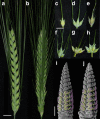Barley SIX-ROWED SPIKE3 encodes a putative Jumonji C-type H3K9me2/me3 demethylase that represses lateral spikelet fertility
- PMID: 29038434
- PMCID: PMC5643332
- DOI: 10.1038/s41467-017-00940-7
Barley SIX-ROWED SPIKE3 encodes a putative Jumonji C-type H3K9me2/me3 demethylase that represses lateral spikelet fertility
Abstract
The barley inflorescence (spike) comprises a multi-noded central stalk (rachis) with tri-partite clusters of uni-floretted spikelets attached alternately along its length. Relative fertility of lateral spikelets within each cluster leads to spikes with two or six rows of grain, or an intermediate morphology. Understanding the mechanisms controlling this key developmental step could provide novel solutions to enhanced grain yield. Classical genetic studies identified five major SIX-ROWED SPIKE (VRS) genes, with four now known to encode transcription factors. Here we identify and characterise the remaining major VRS gene, VRS3, as encoding a putative Jumonji C-type H3K9me2/me3 demethylase, a regulator of chromatin state. Exploring the expression network modulated by VRS3 reveals specific interactions, both with other VRS genes and genes involved in stress, hormone and sugar metabolism. We show that combining a vrs3 mutant allele with natural six-rowed alleles of VRS1 and VRS5 leads to increased lateral grain size and greater grain uniformity.The VRS genes of barley control the fertility of the lateral spikelets on the barley inflorescence. Here, Bull et al. show that VRS3 encodes a putative Jumonji C-type histone demethylase that regulates expression of other VRS genes, and genes involved in stress, hormone and sugar metabolism.
Conflict of interest statement
The authors declare no competing financial interests.
Figures





Similar articles
-
Interaction between row-type genes in barley controls meristem determinacy and reveals novel routes to improved grain.New Phytol. 2019 Mar;221(4):1950-1965. doi: 10.1111/nph.15548. Epub 2018 Nov 27. New Phytol. 2019. PMID: 30339269 Free PMC article.
-
Six-Rowed Spike3 (VRS3) Is a Histone Demethylase That Controls Lateral Spikelet Development in Barley.Plant Physiol. 2017 Aug;174(4):2397-2408. doi: 10.1104/pp.17.00108. Epub 2017 Jun 27. Plant Physiol. 2017. PMID: 28655778 Free PMC article.
-
Six-rowed spike4 (Vrs4) controls spikelet determinacy and row-type in barley.Proc Natl Acad Sci U S A. 2013 Aug 6;110(32):13198-203. doi: 10.1073/pnas.1221950110. Epub 2013 Jul 22. Proc Natl Acad Sci U S A. 2013. PMID: 23878219 Free PMC article.
-
The importance of barley genetics and domestication in a global perspective.Ann Bot. 2007 Nov;100(5):999-1008. doi: 10.1093/aob/mcm139. Epub 2007 Aug 30. Ann Bot. 2007. PMID: 17761690 Free PMC article. Review.
-
Epigenetic gene regulation by plant Jumonji group of histone demethylase.Biochim Biophys Acta. 2011 Aug;1809(8):421-6. doi: 10.1016/j.bbagrm.2011.03.004. Epub 2011 Mar 16. Biochim Biophys Acta. 2011. PMID: 21419882 Review.
Cited by
-
Exploring the crop epigenome: a comparison of DNA methylation profiling techniques.Front Plant Sci. 2023 May 30;14:1181039. doi: 10.3389/fpls.2023.1181039. eCollection 2023. Front Plant Sci. 2023. PMID: 37389288 Free PMC article. Review.
-
Genome-wide characterization and evolution analysis of miniature inverted-repeat transposable elements in Barley (Hordeum vulgare).Front Plant Sci. 2024 Oct 31;15:1474846. doi: 10.3389/fpls.2024.1474846. eCollection 2024. Front Plant Sci. 2024. PMID: 39544535 Free PMC article.
-
A Comparison of Mainstream Genotyping Platforms for the Evaluation and Use of Barley Genetic Resources.Front Plant Sci. 2019 Apr 26;10:544. doi: 10.3389/fpls.2019.00544. eCollection 2019. Front Plant Sci. 2019. PMID: 31105733 Free PMC article.
-
Are cereal grasses a single genetic system?Nat Plants. 2024 May;10(5):719-731. doi: 10.1038/s41477-024-01674-3. Epub 2024 Apr 11. Nat Plants. 2024. PMID: 38605239 Free PMC article.
-
New loci and candidate genes in spring two-rowed barley detected through meta-analysis of a field trial European network.Theor Appl Genet. 2025 Jun 23;138(7):158. doi: 10.1007/s00122-025-04934-8. Theor Appl Genet. 2025. PMID: 40549197 Free PMC article.
References
-
- Takahashi R, et al. Basic studies on breeding barley by the use of two-rowed and six-rowed varietal crosses. Jpn. J. Breed. 1975;25:334–342. doi: 10.1270/jsbbs1951.25.334. - DOI
Publication types
MeSH terms
Substances
LinkOut - more resources
Full Text Sources
Other Literature Sources
Miscellaneous

